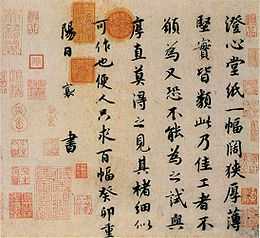Cai Xiang

Cai Xiang (Chinese: 蔡襄; pinyin: Cài Xiāng; Wade–Giles: Ts'ai Hsiang) (1012–1067) was a Chinese calligrapher, scholar, official, structural engineer, and poet.[1] Cai Xiang had the reputation as the greatest calligrapher in the Song Dynasty.
Life
Cai Xiang's Style name was Junmo (君谟), and his posthumous name was Zhonghuei. He was born in the Xiangfu reign of the Song dynasty in Xianyou (仙游) county of Xinghua (兴化) prefecture, now Xianyou County in Putian of Fujian Province.
During the Chingli reign (1042–1048 AD), Cai Xiang was the Officer of Transportation ( Zhuanyunshi) in Fujian. While acting as a prefect in Fujian, he also was in charge of overseeing the construction of the Wan-an Bridge at Quanzhou. In Tiansheng the eighth year (1030 AD) Cai Xiang obtain the degree of jinshi. His highest rank was Duanmingdian Xueshi, (secretariat Drafter of Duanming Court ) in charge of written communication of imperial government.
He pioneered the manufacturing of small Dragon Tribute Tea Cake of superlative quality, as it was reputed to be harder to obtain than gold. In his Tea Note written between 1049 and 1053, he criticized the traditional method of mixing small amount of Dryobalanops aromatica camphor into tea cake:
"Tea has intrinsic aroma. But tribute tea manufacturers like to mix small amount of Dryobalanops aromatica camphor, supposedly to enhance the aroma. The local people of Jian'an never mix any incense into tea, afraid to robe the natural aroma of tea".
"Tea abhors incense".
Works of Cai Xiang
- Calligraphy: Wan'an Bridge Report Tablet
- Poetry: Collected Works of Cai Zhonghuei
- Essay: Tea Note (1049–1053)
- Letter: Letter on Cheng Xin Tang Paper

See also
- Architecture of the Song Dynasty
References
- ↑ Ci hai bian ji wei yuan hui (辞海编辑委员会). Ci hai (辞海). Shanghai: Shanghai ci shu chu ban she (上海辞书出版社), 1979. Page 610.
| Wikimedia Commons has media related to Cai Xiang. |
|